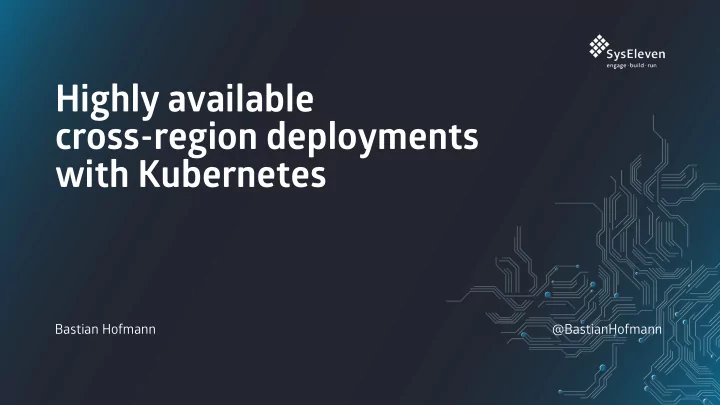

Highly available cross-region deployments with Kubernetes Bastian Hofmann @BastianHofmann
Container orchestration platform
Deploy, run and scale your services in isolated containers
No vendor lock in
Standardized APIs
Runs on
Your laptop
Bare metal
Cloud Providers
And if you don't want to install and maintain Kubernetes yourself
Managed Kubernetes
Self-healing built in
But what happens when a complete datacenter is not available
Multi-Region Kubernetes Setups
Why
Availability
Scalability
More Points-of-Presence
Reduce dependencies on one single cloud provider
Because of the standardised API across providers Kubernetes can help
Features
Scheduling by Node Labels
failure- domain.beta.kubernetes.io/ region=dbl failure- domain.beta.kubernetes.io/ zone=dbl1
Regions vs availability zone
failure- domain.beta.kubernetes.io/ region=dbl failure- domain.beta.kubernetes.io/ zone=dbl1
apiVersion: apps/v1 kind: Deployment metadata: name: nginx spec: template: spec: containers: - image: nginx name: nginx nodeSelector: failure-domain.beta.kubernetes.io/region: dbl
Affinities
spec: affinity: podAntiAffinity: requiredDuringSchedulingIgnoredDuringExecution: - topologyKey: "failure-domain.beta.kubernetes.io/ region" labelSelector: matchLabels: app: nginx
Service discovery with built in DNS
apiVersion: v1 kind: Service metadata: name: nginx spec: type: ClusterIP ports: - port: 80 targetPort: 80 selector: app: nginx
External LoadBalancers
apiVersion: v1 kind: Service metadata: name: nginx spec: type: LoadBalancer ports: - port: 80 targetPort: 80 selector: app: nginx
external-dns
StorageClasses
Some storage providers support dynamic volume provisioning
apiVersion: storage.k8s.io/v1 kind: StorageClass metadata: name: standard provisioner: kubernetes.io/gce-pd parameters: type: pd-standard volumeBindingMode: WaitForFirstConsumer allowedTopologies: - matchLabelExpressions: - key: failure-domain.beta.kubernetes.io/zone values: - us-central1-a - us-central1-b
Challenges
Especially over different regions
External load balancing and traffic management
Internal load balancing
Connectivity between private networks
Kubernetes DNS across multiple clusters
Latencies
Beskow, Paul & Vik, Knut-Helge & Halvorsen, Pål & Griwodz, Carsten. (2009). The partial migration of game state and dynamic server selection to reduce latency. Multimedia Tools Appl.. 45. 83-107. 10.1007/s11042-009-0287-7.
Synchronising Deployments across multiple clusters
Storage
Data replication
Split-brain problem
Possible setups
One cluster across AZs in one region
One cluster across regions
Multiple clusters connected via VPN
One cluster setup
One Kubernetes cluster across multiple availability zones
Zone 1 Zone 2 Kubernetes Master Components Curl Nginx Service Nginx Nginx
Easiest option
Low latencies
You can use one network
All pods and services can talk with each other
One cluster => one internal DNS
Service Discovery and internal load balancing works
External LoadBalancers work
LB Zone 1 Zone 2 Kubernetes Master Components Curl Nginx Service Nginx Nginx
You can mount storage across AZ
One cluster state => One deployment
But what if the whole region is down?
One Kubernetes cluster across multiple regions and VPN connection between networks
Region 1 Region 2 Kubernetes Master Components WireGuard VPN Curl Nginx Service Nginx Nginx
Latencies get higher by distance
You need a VPN to connect the networks
WireGuard as a VPN
https:/ /github.com/squat/kilo
Kilo gets all Nodes from Kubernetes
Discovers regions and zones by Kubernetes Node labels
Configures WireGuard
Routing tables
All pods and services can talk with each other
One cluster => one internal DNS
Service Discovery and internal load balancing works
You need a solution for external load balancing
Region 1 Region 2 LB LB Kubernetes Master Components WireGuard VPN Curl Nginx Service Nginx Nginx
You have to replicate storage yourself
Not every Storage provider supports dynamic volume provisioning
One cluster state => One deployment
Demo
Multi cluster setup
Connecting multiple clusters with a VPN
Cluster 1 Cluster 2 Kubernetes Master Kubernetes Master Components Components WireGuard VPN Curl Nginx Service Nginx Service Nginx Nginx
WireGuard as a VPN
https:/ /github.com/squat/kilo
All pods and services can talk with each other
Separate clusters => separate internal DNS
For service discovery configure each internal DNS to resolve to other clusters
cluster.region2:53 { forward . 10.10.11.10 } .:53 { kubernetes cluster.local cluster.region1 in-addr.arpa ip6.arpa { pods insecure upstream fallthrough in-addr.arpa ip6.arpa } forward . /etc/resolv.conf loop loadbalance }
cluster.region1:53 { forward . 10.10.10.10 } .:53 { kubernetes cluster.local cluster.region2 in-addr.arpa ip6.arpa { pods insecure upstream fallthrough in-addr.arpa ip6.arpa } forward . /etc/resolv.conf loop loadbalance }
Internal load balancing works
You have to replicate storage yourself
Every cluster has their own StorageClass that works on all nodes
Recommend
More recommend